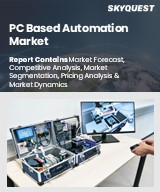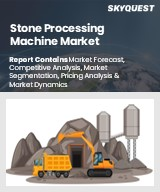
|
시장보고서
상품코드
1385466
아시아태평양의 자율 시스템의 미래 : 자율 내비게이션 소프트웨어 시장 - 분석 및 예측(2023-2033년)Asia-Pacific Future of Autonomous Systems-Focus on Autonomous Navigation Software Market: Analysis and Forecast, 2023-2033 |
||||||
아시아태평양의 자율 내비게이션 소프트웨어 시장 규모는 2022년 6억 9,170만 달러로 평가되며, 2033년에는 13억 6,180만 달러에 달할 것으로 예상됩니다.
이 시장은 디지털 기술의 지속적인 개발 및 도입, 자율 주행 기술 사용을 장려하는 정부 프로그램, 제조, 운송, 의료, 농업 등 다양한 분야의 효율성 및 자동화 요구가 증가함에 따라 주도될 것으로 예상됩니다. 또한, 중요한 공정에서 인적 오류를 줄이고 안전성을 높이기 위한 필요성이 증가함에 따라 자율 주행 시스템 도입이 가속화될 것으로 예상됩니다.
| 주요 시장 통계 | |
|---|---|
| 예측 기간 | 2023-2033년 |
| 2023년 평가 | 7억 2,500만 달러 |
| 2033년 예측 | 13억 6,180만 달러 |
| CAGR | 6.51% |
아시아태평양(APAC) 시장은 특히 자율 내비게이션 소프트웨어에 중점을 둔 자율 주행 시스템 산업의 잠재적 확장으로 인해 가까운 미래에 큰 성장을 이룰 것으로 예상됩니다. 지속가능성과 환경적 책임에 대한 관심 증가 등 여러 요인이 이러한 성장을 촉진하고 있습니다. 하지만 사이버 보안 위협, 윤리적 및 법적 문제, 높은 도입 비용 등의 장애물이 자율 시스템의 광범위한 사용을 가로막고 있습니다. 이러한 장애물을 극복하기 위해서는 업계 관계자와 정책 입안자들이 이러한 장애물을 해결해야 합니다. 한편, 시장에서는 생산성 향상, 확장성, 지속적인 기술 혁신, 디지털 기술 채택, 비용 절감의 필요성이 시장을 주도하고 있습니다. 또한, 자율 주행 시스템의 사용 증가는 자율 주행 트럭, 버스, 셔틀버스, 드론 배송 네트워크와 같은 새로운 비지니스 모델의 도입을 촉진할 것으로 보입니다. 자율 주행 플랫폼의 발전은 전통적인 산업을 파괴할 수 있는 잠재력을 가지고 있으며, 생태계 내 기존 이해관계자와 새로운 이해관계자 모두에게 새로운 기회를 창출할 수 있습니다.
이 보고서는 아시아태평양의 자율 내비게이션 소프트웨어 시장을 조사하여 시장 개요와 함께 부문별, 플랫폼별, 국가별 동향, 시장 진입 기업 개요 등을 제공합니다.
목차
제1장 시장
- 업계 전망
- 비지니스 역학
제2장 아시아태평양
- 자율 시스템의 미래 : 자율 내비게이션 소프트웨어 시장(지역별)
- 아시아태평양
제3장 경쟁 벤치마킹과 기업 개요
- 시장 점유율 분석
제4장 조사 방법
ksm 23.12.01“The Asia-Pacific Future of Autonomous Systems-Focus on Autonomous Navigation Software Market Expected to Reach $1,361.8 Million by 2033.”
Introduction to Asia-Pacific Future of Autonomous Systems: Focus on Autonomous Navigation Software Market
The Asia-Pacific future of autonomous systems: focus on autonomous navigation software market was valued at $691.7 million in 2022, and it is expected to be $1,361.8 million by 2033. This market is anticipated to be propelled by the ongoing development and uptake of digital technologies, government programs encouraging the use of autonomous technologies, and the growing need for efficiency and automation across a range of sectors, including manufacturing, transportation, healthcare, and agriculture. Additionally, it is anticipated that the adoption of autonomous systems would be fueled by the growing need to decrease human error and increase safety in key processes.
| KEY MARKET STATISTICS | |
|---|---|
| Forecast Period | 2023 - 2033 |
| 2023 Evaluation | $725.0 Million |
| 2033 Forecast | $1,361.8 Million |
| CAGR | 6.51% |
Market Introduction
It is expected that the Asia-Pacific (APAC) market would witness significant growth in the near future due to the potential expansion of the autonomous systems industry, with a particular emphasis on autonomous navigation software. Numerous causes, such as the growing emphasis on sustainability and environmental responsibility, are driving this expansion. Nevertheless, obstacles including cybersecurity threats, ethical and legal issues, and high implementation costs stand in the way of autonomous systems' broad use. It is imperative that industry players and policymakers tackle these obstacles in order to enable widespread implementation. On the other hand, the market is propelled by the need for increased productivity, scalability, ongoing technical innovation, digital technology adoption, and cost reduction. Furthermore, the increasing use of autonomous systems is probably going to result in the introduction of new business models, like autonomous trucks, buses, shuttles, and drone delivery networks. The advancements in autonomous platforms have the potential to disrupt traditional industries, creating new opportunities for both established and emerging stakeholders in the ecosystem.
Market Segmentation
Segmentation 1: by Sector
- Commercial
- Military
- Civil Government
Segmentation 2: by Platform
- Autonomous Vehicle (Trucks/Buses/Vans)
- Unmanned Aerial Vehicle (UAV)
- Unmanned Underwater Vehicle (UUV)
- Unmanned Surface Vehicle (USV)
- Autonomous Mobile Robot
- Collaborative Robot (Cobot)
- Humanoid
Segmentation 3: by Country
- China
- Japan
- India
- Australia
- Rest-of-Asia-Pacific
How can this report add value to an organization?
Growth/Marketing Strategy: The Asia-Pacific future of autonomous systems: focus on autonomous navigation software market has seen major development activities by key players operating in the market, such as business expansion activities, contracts, mergers, partnerships, collaborations, and joint ventures. The most favored strategy for the companies has been contracts to strengthen their position in the Asia-Pacific future of autonomous systems: focus on autonomous navigation software market.
Competitive Strategy: Key players in the Asia-Pacific future of autonomous systems: focus on autonomous navigation software market analyzed and profiled in the study involve autonomous systems manufacturers that offer platforms such as autonomous mobile robots (AMRs), humanoids, unmanned aerial vehicles (UAVs), unmanned surface vehicles (USVs), collaborative robots (Cobots), and unmanned underwater vehicles (UUVs). Moreover, a detailed market share analysis of the players operating in the future of autonomous systems: focus on autonomous navigation software market offers advanced technologies such as thermal stereo sensing in autonomous vehicles, artificial intelligence, and computer vision technologies. These technologies are enabling the development of more sophisticated autonomous systems that can perform increasingly complex tasks with greater speed and accuracy. Additionally, comprehensive competitive strategies such as contracts, partnerships, agreements, acquisitions, and collaborations will aid the reader in understanding the untapped revenue pockets in the market.
Key manufacturers of the future of autonomous systems: focus on autonomous navigation software market operating in the Asia-Pacific region are:
|
|
Table of Contents
1 Market
- 1.1 Industry Outlook
- 1.1.1 Evolution of Autonomous Systems: Overview
- 1.1.2 Start-ups and Investment Landscape
- 1.1.3 Ongoing and Upcoming Projects
- 1.1.4 Prioritising Environmental, Social, and Governance (ESG) Requirements
- 1.1.5 Patent Analysis
- 1.1.6 Current and Futuristic Trends
- 1.1.6.1 Thermal Stereo Sensing in Autonomous Vehicles
- 1.1.6.2 Rapid Developments in Humanoid Robots Technology
- 1.1.6.3 Use of 360-Degree Stabilized Vision and Depth Collision in Autonomous Systems
- 1.1.7 Supply Chain Analysis
- 1.1.8 Evolving Autonomous Software Solutions and Machines: Focus Areas and the Future
- 1.2 Business Dynamics
- 1.2.1 Business Drivers
- 1.2.1.1 Continuous Advancements and Adoption of Digital Technologies
- 1.2.1.2 Government Initiatives for Adoption of Autonomous Technologies
- 1.2.1.3 Increased Need to Reduce Human Errors
- 1.2.2 Business Challenges
- 1.2.2.1 High Costs and Complexity Involved in the Development of Autonomous Solutions
- 1.2.2.2 Lack of Advanced Communication Infrastructure
- 1.2.2.3 Requirement of Fixed Infrastructure to Operate Autonomous Systems
- 1.2.3 Business Strategies
- 1.2.3.1 New Product Launches
- 1.2.3.2 Partnerships, Collaborations, Agreements, and Contracts
- 1.2.4 Business Opportunities
- 1.2.4.1 Increasing Adoption of Autonomous Systems across Industries
- 1.2.4.2 Rising Investments in Autonomous Technology
- 1.2.1 Business Drivers
2 Asia-Pacific
- 2.1 Future of Autonomous systems: Focus on Autonomous Navigation Software Market (by Region)
- 2.2 Asia-Pacific
- 2.2.1 Markets
- 2.2.1.1 Key Players in Asia-Pacific
- 2.2.1.2 Business Drivers
- 2.2.1.3 Business Challenges
- 2.2.2 Application
- 2.2.2.1 Asia-Pacific Future of Autonomous Systems: Focus on Autonomous Navigation Software Market (by Sector)
- 2.2.3 Product
- 2.2.3.1 Asia-Pacific Future of Autonomous Systems: Focus on Autonomous Navigation Software Market (by Platform)
- 2.2.4 Asia-Pacific (by Country)
- 2.2.4.1 China
- 2.2.4.1.1 Markets
- 2.2.4.1.1.1 Key Players in China
- 2.2.4.1.2 Application
- 2.2.4.1.2.1 China Future of Autonomous Systems: Focus on Autonomous Navigation Software Market (by Sector)
- 2.2.4.1.3 Product
- 2.2.4.1.3.1 China Future of Autonomous Systems: Focus on Autonomous Navigation Software Market (by Platform)
- 2.2.4.1.1 Markets
- 2.2.4.2 India
- 2.2.4.2.1 Market
- 2.2.4.2.1.1 Key Players in India
- 2.2.4.2.2 Application
- 2.2.4.2.2.1 India Future of Autonomous Systems: Focus on Autonomous Navigation Software Market (by Sector)
- 2.2.4.2.3 Product
- 2.2.4.2.3.1 India Future of Autonomous Systems: Focus on Autonomous Navigation Software Market (by Platform)
- 2.2.4.2.1 Market
- 2.2.4.3 Japan
- 2.2.4.3.1 Markets
- 2.2.4.3.1.1 Key Players in Japan
- 2.2.4.3.2 Application
- 2.2.4.3.2.1 Japan Future of Autonomous Systems: Focus on Autonomous Navigation Software Market (by Sector)
- 2.2.4.3.3 Product
- 2.2.4.3.3.1 Japan Future of Autonomous Systems: Focus on Autonomous Navigation Software Market (by Platform)
- 2.2.4.3.1 Markets
- 2.2.4.4 Australia
- 2.2.4.4.1 Markets
- 2.2.4.4.1.1 Key Players in Australia
- 2.2.4.4.2 Application
- 2.2.4.4.2.1 Australia Future of Autonomous Systems: Focus on Autonomous Navigation Software Market (by Sector)
- 2.2.4.4.3 Product
- 2.2.4.4.3.1 Australia Future of Autonomous Systems: Focus on Autonomous Navigation Software Market (by Platform)
- 2.2.4.4.1 Markets
- 2.2.4.5 Rest-of-Asia-Pacific
- 2.2.4.5.1 Market
- 2.2.4.5.1.1 Key Players in the Rest-of-Asia-Pacific
- 2.2.4.5.2 Application
- 2.2.4.5.2.1 Rest-of-Asia-Pacific Future of Autonomous Systems: Focus on Autonomous Navigation Software Market (by Sector)
- 2.2.4.5.3 Product
- 2.2.4.5.3.1 Rest-of-Asia-Pacific Future of Autonomous Systems: Focus on Autonomous Navigation Software Market (by Platform)
- 2.2.4.5.1 Market
- 2.2.4.1 China
- 2.2.1 Markets
3 Competitive Benchmarking and Company Profiles
- 3.1 Market Share Analysis
4 Research Methodology
- 4.1 Factors for Data Prediction and Modeling



















